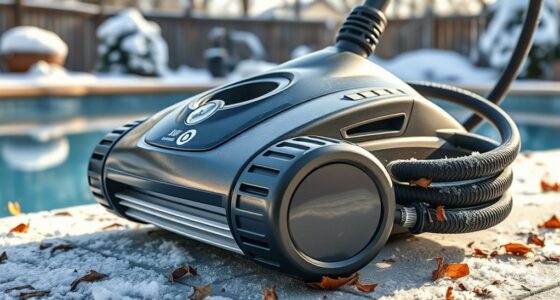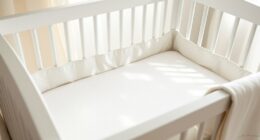Choosing the right flooring for your home can significantly affect its look, durability, and value. You'll want to consider options like hardwood for elegance and longevity, or laminate for budget-friendly appeal. Think about the lifespan of each material; for instance, hardwood can last up to 100 years with care, while laminate typically lasts 15-25 years. Installation methods vary, so pick one that fits your skills and comfort level. Also, don't overlook maintenance needs and cost considerations. Ready to make an informed choice? There's more essential information just ahead to help you decide.
Key Takeaways
- Assess the durability and lifespan of flooring types; hardwood lasts 75-100 years, while laminate lasts 15-30 years.
- Consider the installation method that suits your skill level; options include nail-down, interlocking, glue-down, and staple-down techniques.
- Evaluate your budget, factoring in both material and installation costs to find the best value for your needs.
- Choose flooring that fits the intended space; luxury vinyl is ideal for kitchens, while hardwood adds elegance to living areas.
- Prioritize maintenance requirements; high-maintenance options like hardwood need regular care, while laminate is easier to maintain.
Durability and Lifespan

When you're choosing flooring for your home, durability and lifespan are crucial factors to consider.
Hardwood flooring can last an impressive 75 to 100 years with proper maintenance, though it requires refinishing every 10 to 20 years. The hardness of wood influences its resistance to scratches and dents, making it a smart choice for high-traffic areas.
Laminate flooring, on the other hand, typically lasts 15 to 25 years, but high-quality options can stretch that to 30 years.
Tile flooring generally survives over 50 years, especially if you opt for durable porcelain tiles.
Waterproof vinyl flooring tends to last 10 to 20 years, depending on quality and maintenance.
Types of Flooring
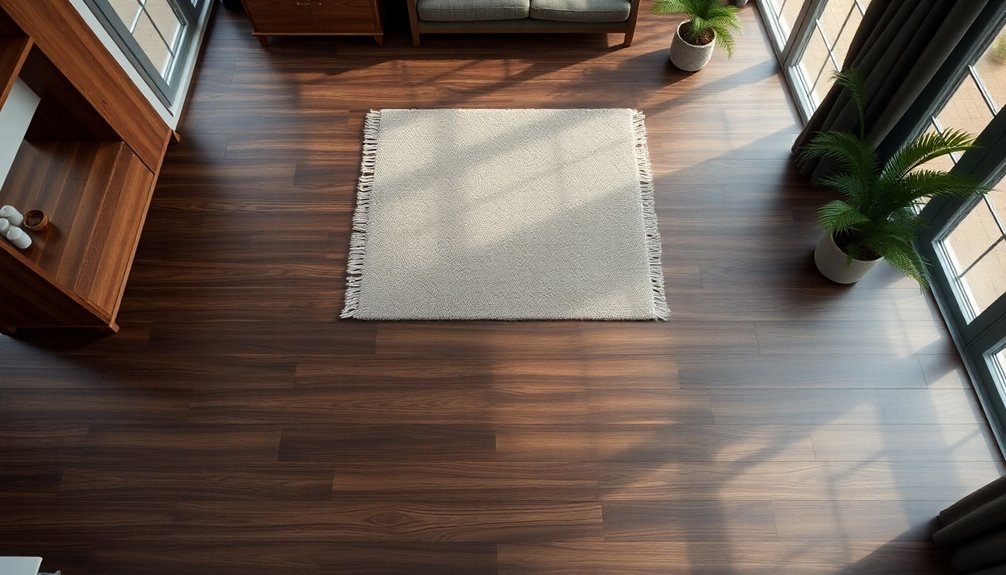
Choosing the right flooring can feel overwhelming, especially with the variety of options available.
You've got classic hardwood, which adds timeless elegance and boosts property value while being easy to maintain. Hardwood flooring is also known for its unique patterns and natural knots, making each piece distinct.
If you prefer affordability, laminate flooring mimics wood and stone looks but isn't as strong, making it better for low-traffic areas.
Luxury vinyl tiles (LVT, SPC, WPC) offer affordable luxury and come in many designs, perfect for kitchens and bathrooms with their slip-resistant features.
Other resilient options like cork, linoleum, and rubber provide unique benefits, such as sound dampening and eco-friendliness.
Finally, vinyl sheet and tiles are easy to install and water-resistant, making them ideal for DIY projects in moisture-prone areas.
Installation Methods
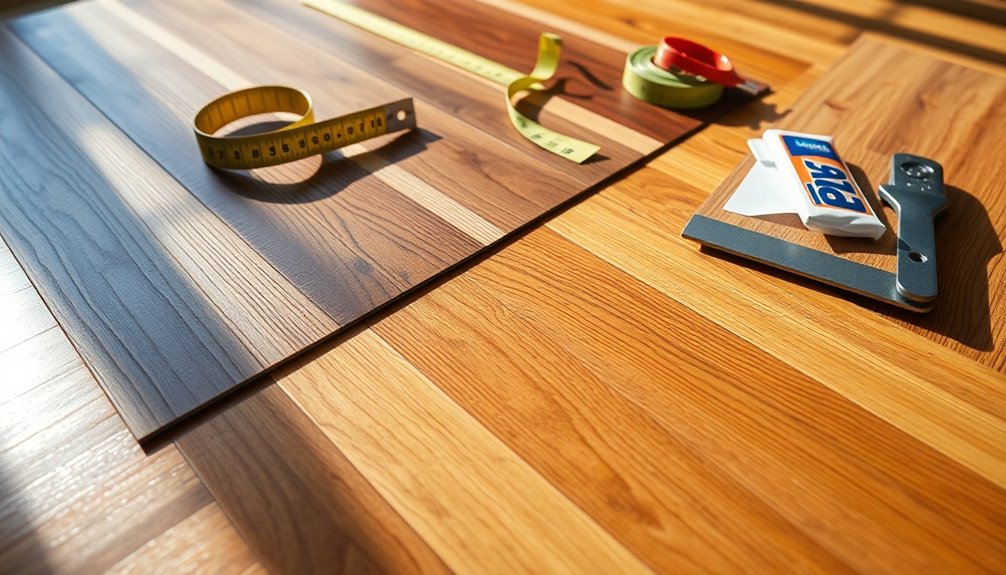
Selecting the right installation method for your flooring can significantly impact the overall look and longevity of your home. You've got several options to consider.
The nail-down method is cost-effective and ideal for wood subfloors, using a specialized nail gun to secure boards. This method is particularly suitable for 3/4-inch solid hardwood, which enhances durability and performance.
If you're a DIY enthusiast, the interlocking (click-lock) method is perfect, allowing boards to snap together quickly with no specific subfloor needed.
For concrete floors, the glue-down method involves applying adhesive and ensuring proper alignment.
Lastly, the staple-down technique uses staples for securing boards on wood subfloors, but it may not handle movement as well as nails.
Choose the method that best fits your flooring type and installation comfort level.
Maintenance and Care
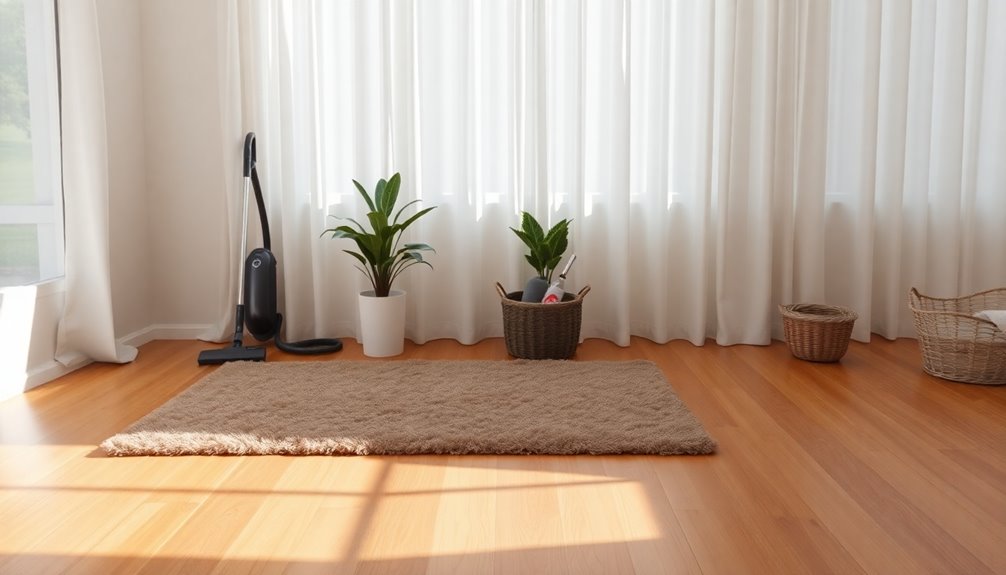
To keep your flooring looking its best and lasting longer, regular maintenance is essential.
Start by sweeping or vacuuming at least once a week to remove dirt and debris. Use a soft-bristled broom or a vacuum with a gentle brush attachment, paying extra attention to corners, edges, and under furniture. Consider implementing a regular cleaning routine to ensure that your floors are consistently cared for.
For mopping, choose a pH-neutral cleaner designed for your flooring type and avoid harsh chemicals. If you have hybrid or timber floors, dry them thoroughly after mopping to prevent water spots or damage.
Address spills promptly to avoid stains, and remember to place mats at entrances to minimize dirt buildup.
Cost Considerations
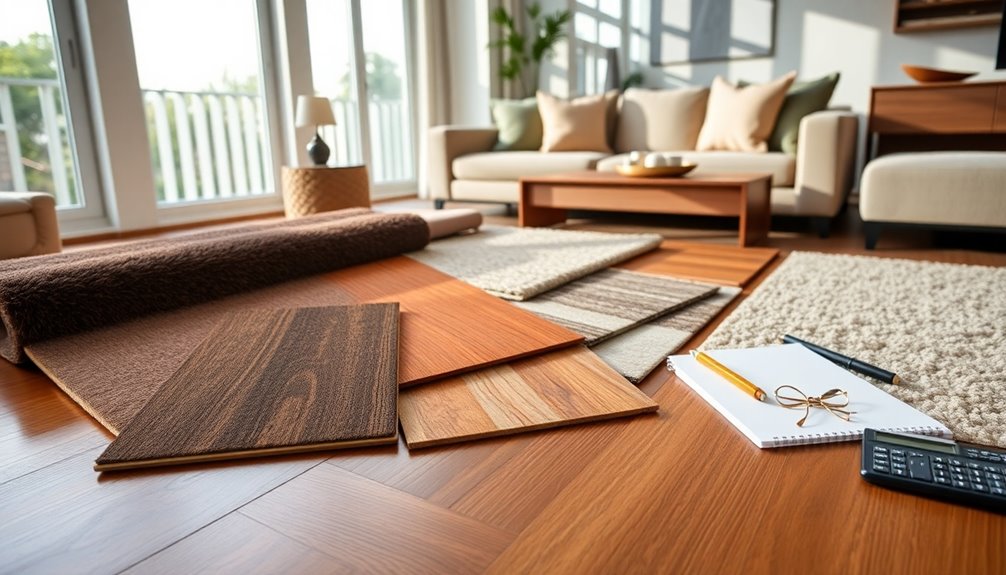
When it comes to flooring, understanding the costs involved can make a significant difference in your budgeting and overall satisfaction.
Material costs vary widely, from laminate at $1 to $5 per square foot to hardwood priced between $6 and $25. Installation costs also add up; hardwood installation ranges from $3 to $8 per square foot, while laminate is more affordable at $1 to $3.
Don't forget to factor in additional costs like underlayment and removal of old flooring. Your project size and location can influence pricing, with discounts for larger areas and urban locations generally having higher costs.
Finally, consider resale value—investing in quality materials like hardwood can significantly boost your property's worth.
Environmental Impact
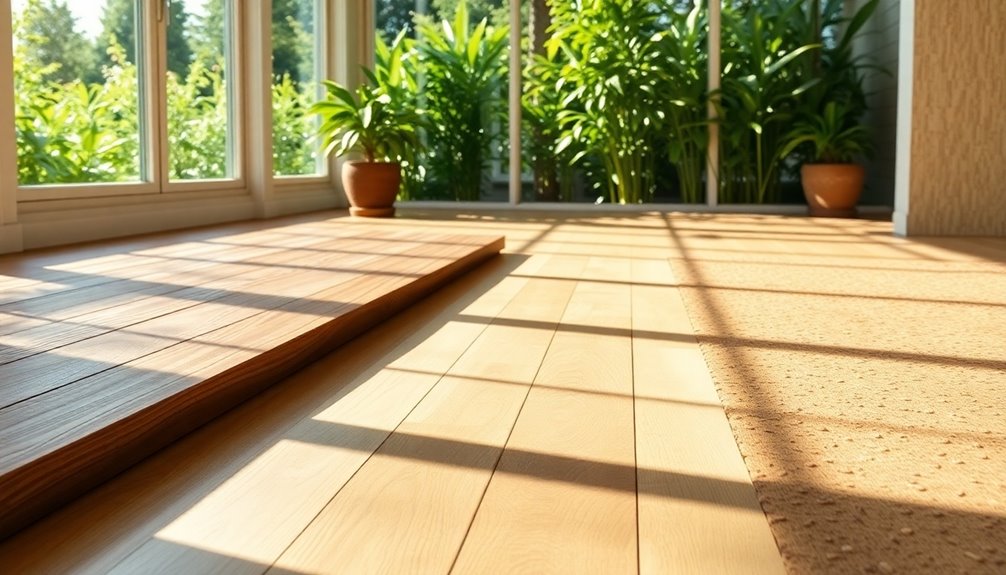
As you consider flooring options for your home, it's crucial to evaluate their environmental impact.
Vinyl flooring not only emits hidden carbon dioxide but also releases toxic chemicals during production, harming communities and ecosystems. In fact, vinyl flooring production emissions have been found to be underestimated by up to 180%, highlighting the urgent need for awareness.
In contrast, engineered wood and cork flooring are sourced sustainably, minimizing resource usage and promoting eco-friendly practices.
Bamboo, a fast-growing crop, requires minimal water and can be harvested every few years, making it a sustainable choice.
When these materials reach the end of their life cycle, they can be composted or recycled, further reducing waste.
Aesthetic Options
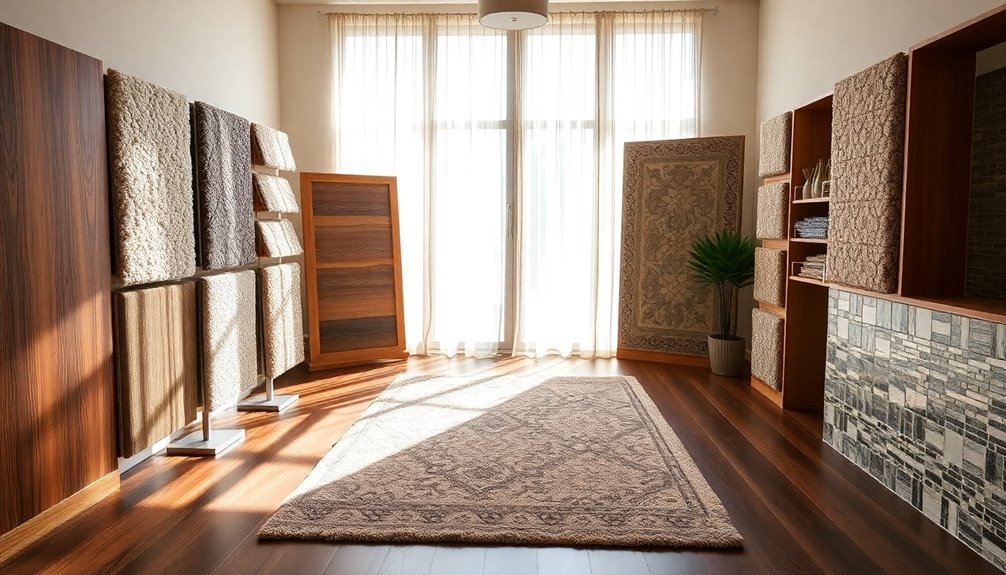
How do you envision your home's aesthetic? If you crave classic elegance, consider marble or polished concrete flooring for a timeless look.
For a more nature-inspired vibe, bamboo or cork flooring can bring the outdoors in. Incorporating natural materials into your design can enhance the overall aesthetic. If you're feeling bold, experiment with terrazzo or patterned tiles that add a playful touch.
Modern aesthetics embrace hardwood or smooth porcelain tiles that blend seamlessly with contemporary designs. You might also explore rustic textures for character or high color variation flooring for a unique, natural feel. Classic wood flooring can offer natural warmth while enhancing rustic charm in your home.
Each option offers a distinct vibe, so think about what resonates with your style and complements your overall home design. Your flooring can set the tone for every space, making it a crucial choice.
Choosing the Right Fit
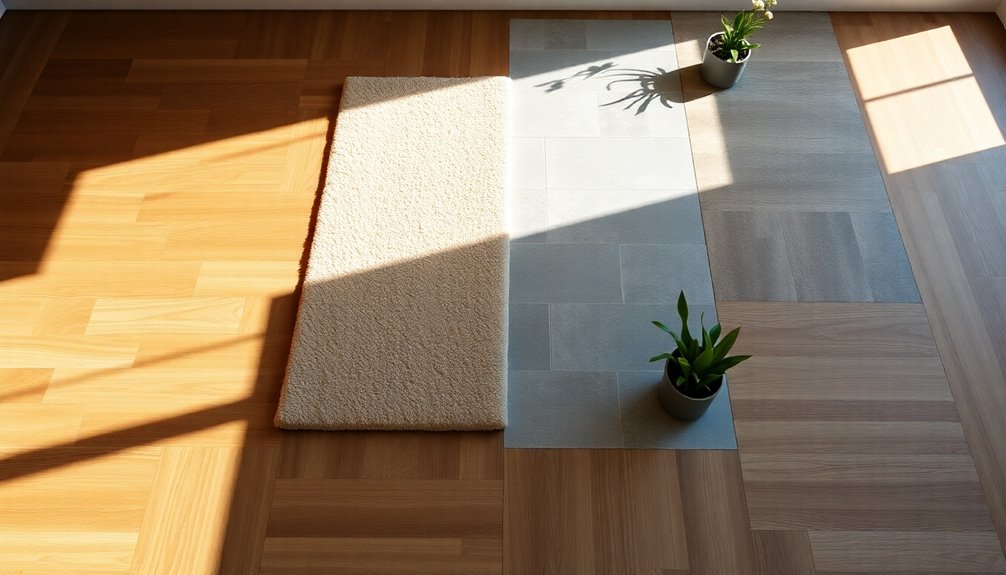
Selecting the right flooring fit for your home involves considering durability, traffic levels, and expected lifespan.
Start by assessing the durability ratings: for carpets, choose AC 1-3 for light to moderate traffic, while AC 4-5 suits heavier use.
For tiles, refer to the PEI ratings; PEI 1-3 is good for residential, and PEI 4 is ideal for commercial areas.
When it comes to hardwood, check the Janka rating—most domestic options handle residential traffic well, while exotic woods are better for high-traffic zones. Additionally, exotic woods often exceed a Janka rating of 2000, making them an excellent choice for durability in busy areas.
Lastly, consider wear layer thickness for vinyl and laminate; thicker layers are essential for commercial settings.
Frequently Asked Questions
What Are the Best Flooring Options for Allergy Sufferers?
If you're looking for the best flooring options for allergy sufferers, consider hardwood, luxury vinyl tile, ceramic or stone tiles, and laminate.
Hardwood's easy to clean and doesn't trap allergens.
Luxury vinyl tile is waterproof and resists dust.
Ceramic and stone tiles are durable and moisture-resistant.
Lastly, laminate offers an affordable, smooth surface that doesn't harbor allergens.
Each option helps create a healthier environment for you and your family.
How Do I Choose the Right Flooring for Pets?
Imagine your home as a welcoming meadow for your furry friends, where their playful paws dance freely.
To choose the right flooring for pets, look for options that resist scratches and stains, like laminate or luxury vinyl. Ensure it's comfortable underfoot, providing good traction to prevent slips.
Easy maintenance is key, too, so go for surfaces that wipe clean effortlessly, allowing you to enjoy more time playing and less time worrying about messes.
Can I Install Flooring Over Existing Flooring?
Yes, you can install flooring over existing flooring, but you'll need to check a few things first.
Ensure the existing floor is clean, level, and in good condition. Smooth surfaces like vinyl are ideal, while textured ones may need extra prep.
Different flooring types have specific requirements, so always follow the manufacturer's guidelines.
If you're unsure, it's smart to consult a flooring professional to ensure a successful installation.
What Is the Average Lifespan of Different Flooring Types?
The average lifespan of flooring types varies significantly.
Hardwood can last 75 to 100 years with proper care, while laminate typically only lasts 15 to 25 years.
Tile flooring is durable, often exceeding 50 years, especially if well-installed.
Carpeting, on the other hand, usually lasts 5 to 15 years, depending on fiber quality.
How Does Humidity Affect Flooring Choices?
Imagine trying to dance on a floor that's constantly changing beneath your feet.
Humidity affects your flooring choices significantly. In high humidity, wood expands and can buckle, while finishes may take hours to dry, leading to a dull appearance.
Moisture-resistant options like luxury vinyl or tile offer stability and durability, making them ideal for humid climates.
Conclusion
Choosing the right flooring for your home isn't just about looks; it's a decision that can impact your life for years. Did you know that hardwood floors can last over 100 years with proper care? By considering durability, maintenance, and aesthetics, you can find the perfect fit for your space. Whether you're going for cozy carpets or sleek tiles, make sure your choice reflects your lifestyle and enhances your home's beauty for years to come.





